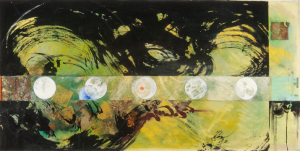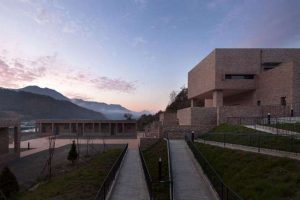Jétsunma Khandro Ten’dzin Drölkar (rJe bTsun ma mKha’ ’gro bsTan ’dzin rGol dKar / རྗེ་བཙུན་མ་མཁའ་འགྲོ་བསྟ་འཛི་སྒྲོལ་དཀར་) ceased to breathe on the morning of 31 March 2024 in McLeod Ganj, in the Indian Himalayas. Normal signs of physical death only appeared nine days later. This is called thukdam (thugs dam / ཐུགས་དམ་)—the period following the death of great lamas, when they dwell in the luminosity of chö-nyid (chos nyid /ཆོས་ཉིད་), the ground of being. During these nine days there was living color, a glow in her face, and no rigor mortis. The most serious study of thukdam undertaken has been by a project of the Center for Healthy Minds, which is associated with the University of Wisconsin. Neuroscientist Richard Davidson, a founder of the center, first encountered thukdam on 28 August 2014, when his Tibetan friend Geshé Lhündrüp Sopa died. Prof. Davidson saw him five days after death had occurred and reported: “There was absolutely no change. It was really quite remarkable.”
Jétsunma was “really quite remarkable” throughout her life—including cooking the best momos (mog mog / མོག་མོག་), fried Tibetan meat dumplings, we’ve ever eaten. She knew I loved momos and cooked them whenever I visited her. She engaged in many mun-tsam (mun mTshams / མུན་མཙམས་) 49-day retreats in total darkness. Mun-tsam develops ja’lü or rainbow body (’ja’ lus / འཇའ་ལུས་). This is not always accompanied by dissolution into rainbow light after death. Thukdam is a sign that this possibility exists, but contributory circumstances are not conducive. During Jétsunma’s thukdam, rainbow-colored sky-phenomena appeared—even at night, around the moon.
I first met Jétsunma on 25 September 1971. I was 19. I’d traveled to the Himalayas hoping to meet a lama of the gö kar chang lo’i dé (gos dKar lCang lo’i sDe / གོས་དཀར་ལྕང་ལོའི་སྡེ་); the white raiment and uncut hair assembly—ngakpas and ngakmas: the non-celibate ordained vanguard of Vajrayana. I was extremely fortunate to meet Jétsunma mere days after arriving in India. I was entranced by her wide-open eyes. She never blinked—but always smiled and often laughed. Her physical poise was majestic and she moved like a ballerina. I can still hear her calling out “Aro Tulku! Chögyam la!” repeatedly, as soon as she espied me approaching the ramshackle assortment of huts that comprised her home and shrine-room. She’d always stand and wave as I clambered up the steep track to her door. She made me feel like her “long-lost son” every time we met.

Jétsunma was the wife of Ngakpa Yeshé Dorje (1926–93). He was popularly known as the “Dalai Lama’s Weather-maker,” and came from a father-to-son Nyingma lineage that dated back to the mahasiddha Togden Tashi. He was a Mahayoga ritual specialist and exorcist, whereas Jétsunma was a Dzogchen yogini. They were both disciples of Kyabjé Düd’jom Rinpoche Jig’drèl Yeshé Dorje, but she was also a disciple of our primary lama, Künzang Dorje Rinpoche, a preeminent Dzogchen master. I learned a great deal from Ngakpa Yeshé Dorje in terms of the ritual aspects of the Düd’jom gTér practice of Tröma Nakmo, but what I learned from Jétsunma was extremely rare. Dzogchen would not reach the West as an available teaching until the late 1980s. What I learned from Jétsunma differed little from what I learned from Künzang Dorje Rinpoche, but it came with her voice and unique warmth. I also received Introduction to the Nature of Mind from Jomo Sam’phel Déchen and Düd’jom Rinpoche. Dzogchen is not in the words but in transmission, and so receiving these teachings three times was unsurpassable for a young Englishman fresh out of art school.
Jétsunma was my friend rather than my lama, by her own insistence. She called me “my dear friend.” She’d never accept the role of lama, regardless of my protestations. She saw us as equal disciples of lamas that we had in common, and, because I’d been recognized by Düd’jom Rinpoche as the incarnation of gTértön Aro Yeshé. For me, she was a realized master who lived in continual practice.
We once traveled to Tso Pema together to visit our lama, Künzang Dorje Rinpoche, and his sangyum Jomo Sam’phel Déchen Rinpoche. We traveled with Sônam Sangpo Rinpoche and received Dzogchen teachings, which Sônam Sangpo Rinpoche translated. Jétsunma was placed, against her wishes, in a seat of honor, which pleased Sônam Sangpo Rinpoche and myself. Künzang Dorje Rinpoche presided as Guru Rinpoche at the Nyingma Dance of the Eight Manifestations of Guru Rinpoche. The next day we all walked up to the mountain caves to visit Lama Wangdor Rinpoche. He knew Jétsunma well and waved away her prostrations. She was a dignitary who never wanted to be a dignitary.

It was never possible to write to tell Jétsunma when Khandro Déchen and I were coming to Nepal because she was always on pilgrimage. She always knew, however. She invariably came to see us in Boudhanath, and it thus transpired that many of our students met her. She was a great inspiration to us all. She always found a translator so that we could speak with each other, and always brought gifts for us and our children.
Jétsunma was born in Long-sha village in Rong-shal, close to the Nepalese border and near Lipshi, where Milarépa practiced. At 16, when her mother died, she went to Zarhombu to her lama, Trülshik Rinpoche, and received the entire Mindröl Ling cycle of the gTérmas. He recognized her as the incarnation of Dag’mèd ma (bDag ’med ma / བདག་མེད་མ་), the consort of Marpa, but she wanted this kept secret during her life. I only found out from Künzang Dorje Rinpoche.
After the Chinese invasion, she fled to Nepal, where she worked on roads or in carpet-making factories. In 1970, she went to McLeod Ganj. There she met Ngakpa Yeshé Dorje. They married and had three children. In 1975, Düd’jom Rinpoche gave his gTérma teaching in Kathmandu, and she went to receive it with me.

She was a friend of Tharchin Rinpoche and highly respected by many lamas, including Dung-sé Thrin-lé Norbu Rinpoche, the eldest son of Düd’jom Rinpoche.
Her son, Trülku Ten’dzin was recognized as the incarnation of Lama Kar-sha Sônam Rinpoche, a disciple of the Drukpa Kagyüd Lama, Togden Shakya Shri. Her two daughters are Tséring Lhamo and Min’gyür Chödrön, who is a friend. She kept us informed over the years about Jétsunma’s whereabouts. Jétsunma was in her 40s when we met, and in her in her late 90s at the end of her life. Her age and date of birth were never of significance to her, so we have no exact dates other the time of her passing. She only showed signs of age toward the end of her life. Every Nyingma lama we’ve known has said that we were lucky to have known her. She was endlessly kind and patient. Her beaming gladness to see us was always overwhelming. We shall carry her image in our heart-minds to our deaths.
See more
Drala Jong
Aro Community
Sang-ngak-chö-dzong
Drala Jong (Facebook)
Aro Ling Bristol (Facebook)
Aro Ling Cardiff (Facebook)
Related features from BDG
The Non-dual Nature of Love in the Tantric Practice of Vajra-Romance: Interview with Mé-tsal Wangmo and Ja’gyür Dorje
Ngakma Mé-tsal Wangmo – A Vicar of Vajrayana
The Path and Practice of Vajra-Romance
On Prejudice, Vajrayana, and the Perception of “Otherness”
Related news reports from BDG
Oxen Becoming Tigers: Online Teaching with Ngak’chang Rinpoche and Khandro Déchen
Entering the Heart of the Sun and Moon: Online Teaching with Ngak’chang Rinpoche and Khandro Déchen
Aro gTér Vajrayana Lineage Celebrates 25th Anniversary of SNCD Buddhist Charity














